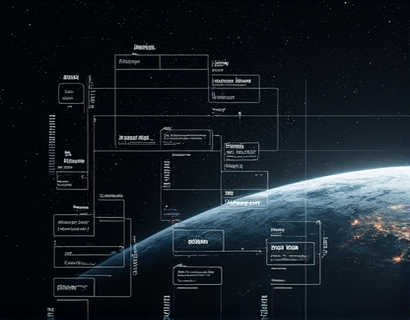Effective Leadership Dashboard: A Game Changer for Streamlined Team Management and Enhanced Productivity
In the fast-paced world of business and organizational management, the ability to efficiently oversee and manage large teams is crucial for success. Effective leadership is not just about setting goals and providing direction; it's also about leveraging the right tools to streamline processes, enhance communication, and make informed decisions. One such tool that has emerged as a transformative solution is the advanced leadership dashboard. This comprehensive platform is designed to empower leaders to manage their teams more effectively, maximize efficiency, and boost productivity across various sectors.
Understanding the Need for a Leadership Dashboard
The traditional methods of team management, while effective to some extent, often fall short in handling the complexities of large and diverse teams. Manual tracking, spreadsheets, and ad-hoc meetings can lead to miscommunication, delays, and a lack of real-time insights. A leadership dashboard addresses these challenges by providing a centralized, real-time view of team performance, project statuses, and key metrics. This tool is particularly valuable for business leaders and organizational managers who need to make data-driven decisions and maintain high levels of productivity.
Key Features of an Advanced Leadership Dashboard
An effective leadership dashboard encompasses a range of features that cater to the multifaceted needs of modern team management.
1. Real-Time Analytics
Real-time analytics are at the core of any advanced dashboard. These analytics provide immediate insights into team performance, project progress, and individual contributions. Leaders can monitor key performance indicators (KPIs) such as task completion rates, time spent on tasks, and resource utilization. This level of visibility allows for quick identification of bottlenecks and areas needing attention, enabling timely interventions.
2. Comprehensive Reporting
Comprehensive reporting tools enable leaders to generate detailed reports with just a few clicks. These reports can cover various aspects such as team productivity, project timelines, budget usage, and employee engagement. Customizable report templates ensure that leaders can focus on the metrics that matter most to their specific goals and objectives. This feature is invaluable for regular progress updates and strategic planning sessions.
3. Collaboration and Communication Tools
Effective communication is the backbone of any successful team. A leadership dashboard integrates collaboration tools that facilitate seamless communication among team members. Features like in-dashboard messaging, file sharing, and integrated video conferencing help break down silos and foster a collaborative environment. This ensures that everyone is on the same page, reducing misunderstandings and accelerating project completion.
4. Task and Project Management
Task and project management functionalities are essential for keeping teams organized and focused. The dashboard allows leaders to assign tasks, set deadlines, and track progress in real-time. Prioritization tools help in managing workloads and ensuring that critical tasks are completed on time. Gantt charts and Kanban boards provide visual representations of project timelines, making it easier to manage complex projects.
5. Employee Performance Tracking
Monitoring employee performance is crucial for identifying strengths and areas for improvement. The dashboard offers detailed performance metrics, including productivity scores, quality of work, and feedback from peers and supervisors. This data-driven approach helps in recognizing high performers and providing targeted support to underperforming team members, fostering a culture of continuous improvement.
6. Resource Management
Efficient resource management is vital for optimizing team productivity. The dashboard provides tools to allocate resources effectively, monitor usage, and prevent overloading of team members. By visualizing resource availability and workloads, leaders can make informed decisions about task assignments and team compositions, ensuring that the right people are working on the right tasks at the right time.
Benefits of Implementing a Leadership Dashboard
The adoption of an advanced leadership dashboard brings numerous benefits that can significantly enhance team management and overall productivity.
1. Improved Decision-Making
With real-time data and comprehensive analytics, leaders can make informed decisions quickly. The dashboard eliminates the need for guesswork and ensures that strategies are based on accurate and up-to-date information. This leads to more effective problem-solving and better outcomes.
2. Enhanced Team Collaboration
The integration of collaboration tools within the dashboard fosters a more cohesive team environment. Team members can communicate seamlessly, share resources, and work together on projects without the need for external platforms. This streamlined approach reduces friction and increases efficiency.
3. Increased Productivity
By automating routine tasks and providing tools for effective task management, the dashboard helps team members focus on high-value activities. The ability to track progress and identify bottlenecks ensures that projects stay on track, leading to higher overall productivity.
4. Better Resource Utilization
Resource management features help in optimizing the use of human and material resources. Leaders can ensure that resources are allocated efficiently, reducing waste and maximizing output. This not only improves productivity but also contributes to cost savings.
5. Enhanced Employee Engagement
When employees have access to clear goals, real-time feedback, and a supportive environment, their engagement and motivation increase. The dashboard's performance tracking and recognition features help in building a positive workplace culture, where employees feel valued and motivated to perform at their best.
Implementing a Leadership Dashboard: Best Practices
To fully leverage the benefits of a leadership dashboard, organizations should follow best practices during implementation and usage.
1. Define Clear Objectives
Before implementing a dashboard, it's essential to define clear objectives and the specific challenges you aim to address. This will guide the selection of features and ensure that the dashboard aligns with your organizational goals.
2. Choose the Right Tool
Select a dashboard that offers the features you need and is scalable to accommodate your growing requirements. Consider factors such as ease of use, integration capabilities, and customer support when making your choice.
3. Train Your Team
Ensure that all team members are trained on how to use the dashboard effectively. Providing comprehensive training sessions and creating user guides can help in smooth adoption and maximize the tool's potential.
4. Foster a Data-Driven Culture
Encourage team members to use the dashboard regularly and rely on data for decision-making. Leadership should set the example by actively using the dashboard and promoting its benefits throughout the organization.
5. Continuously Monitor and Adjust
Regularly review the dashboard's impact on team performance and make adjustments as needed. Solicit feedback from users and stay updated on new features and improvements to ensure the dashboard continues to meet your evolving needs.
Conclusion
In today's competitive business landscape, effective leadership is more critical than ever. An advanced leadership dashboard serves as a powerful tool for streamlining team management, enhancing communication, and driving productivity. By leveraging real-time analytics, comprehensive reporting, and integrated collaboration features, leaders can make informed decisions, optimize resource utilization, and foster a high-performing team environment. Embracing this technology is not just about keeping up with the times; it's about setting the stage for future success.










































